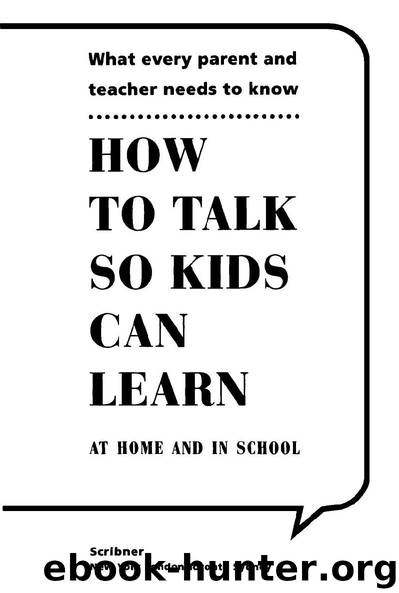How to Talk so Kids Can Learn by Adele Faber & Elaine Mazlish

Author:Adele Faber & Elaine Mazlish
Language: eng
Format: epub
Publisher: SCRIBNER
Published: 1995-07-15T00:00:00+00:00
Questions from Teachers
1. Do you have to go through all the steps of the problem solving process for it to work?
Not necessarily. One teacher described how nine-year-old Spencer, a serious, hardworking student, became angry whenever the other children in his science group fooled around or stopped working—even for a few minutes. One day he lost all control and threw books and papers on the floor. The teacher decided that this latest development warranted the full problem-solving approach.
She sat down with him and started with “Spencer, I can see how much it upsets you when the other children in your group begin to joke around. Once you start on a project, you don’t like to have any interruptions.”
Almost immediately Spencer responded, “Yeah, because I want to finish and they make me forget what I’m doing.” Then, after a short pause, he stood up and said, “Can I go to the back table and work alone when they start to mess around?”
The teacher was startled. She said, “You think that would help?” He nodded and said, “That way I won’t get so mad and throw things.” And from that moment on, that’s how Spencer coped.
2. One of my students, Debby, can never remember to bring her books to school. I tried to problem solve with her, but got nowhere. She just joked around and acted silly. Any suggestions?
If a child resists your efforts to problem solve, a note based upon the same principles can serve as an effective substitute. For example, you might write:
Dear Debby,
You told me that it’s hard for you to remember to bring your books to school and that sometimes you “just forget.”
I need to know that all of my students have their books with them every day so that they can do their work.
Please think of a way to remind yourself to bring your books with you each morning. I’ll think, too. Then let’s exchange ideas and see which one you want to put into action.
Sincerely,
Mrs. G.
3. When a teacher and student are thinking about possible solutions together, is it really necessary to write them down? Isn’t it enough to simply tell them to each other?
Sometimes it is. However, don’t underestimate the rush of pride and pleasure that wells up within a child at seeing his ideas taken seriously enough to be written down by his teacher. The sight of his words on paper not only gives him a visual appreciation of his thought process but inspires him to continue to think creatively.
4. Last week I was problem solving with a girl in my class about her chronic lateness. We were making steady progress until we got to the part where we were supposed to start brainstorming together. I immediately offered two excellent suggestions. She immediately clammed up. What went wrong?
It’s always a good idea to wait after asking a child to brainstorm with you. Let her come up with the first few ideas. Your silence is an invitation, a mark of respect, a way of saying that thoughts need time to form and grow.
Download
This site does not store any files on its server. We only index and link to content provided by other sites. Please contact the content providers to delete copyright contents if any and email us, we'll remove relevant links or contents immediately.
| Early Childhood | Parenting Boys |
| Parenting Girls | School-Age Children |
| Single Parents | Teenagers |
The Lost Art of Listening by Michael P. Nichols(6474)
Rich Dad Poor Dad by Robert T. Kiyosaki(5149)
We Need to Talk by Celeste Headlee(4869)
I Love You But I Don't Trust You by Mira Kirshenbaum(3229)
The Complete Idiot's Guide to Coping With Difficult People by Arlene Uhl(2821)
Rich Dad Poor Dad: What The Rich Teach Their Kids About Money - That The Poor And Middle Class Do Not! by Robert T. Kiyosaki(2434)
Life Hacks by Dan Marshall(2155)
Dealing with People You Can't Stand by Dr. Rick Brinkman(2060)
A Burst of Light by Audre Lorde(1981)
An Odyssey by Daniel Mendelsohn(1922)
The Expectant Father by Armin A. Brott & Jennifer Ash(1894)
The Book You Wish Your Parents Had Read (and Your Children Will Be Glad That You Did) by Philippa Perry(1871)
Teach Your Child How to Think by Edward De Bono(1865)
The Out-of-Sync Child by Carol Stock Kranowitz(1776)
No Time to Say Goodbye(1760)
What I Need by J. Daniels(1720)
I Don't Belong to You by Keke Palmer(1665)
The Self-Driven Child by William Stixrud PhD & Ned Johnson(1661)
The 7 Habits Of Highly Effective Teens by Covey Sean(1632)
